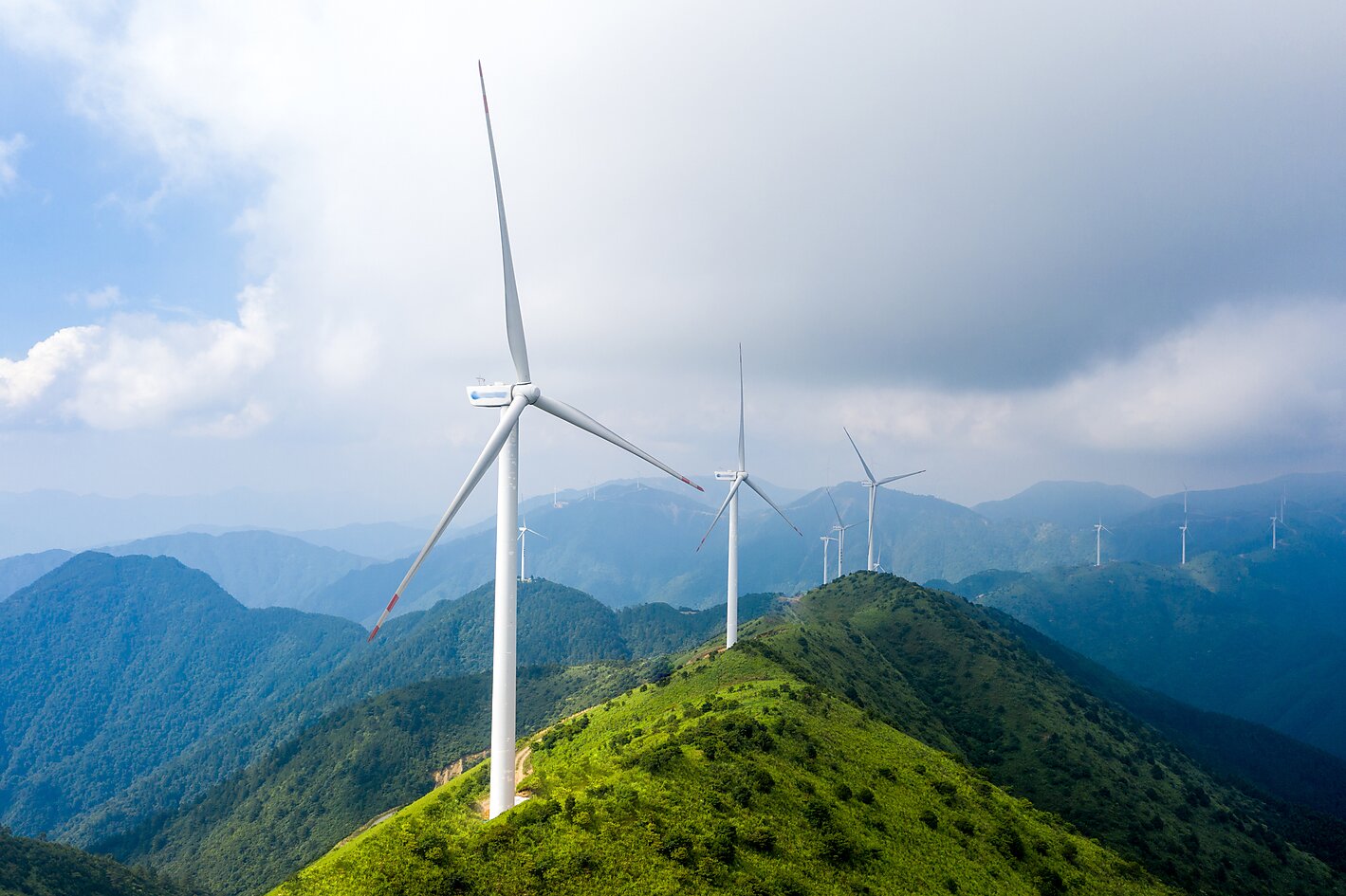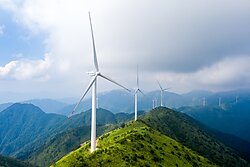-
Globalization has been a huge force for worldwide prosperity, and historically, prosperity has meant more greenhouse gas emissions. But the only practical response to greenhouse gas emissions is to decouple economic growth from emissions.
-
Innovation that drives the cost of zero-carbon technologies below traditional production approaches is the key to that—and the innovation effort spans the globe.
-
Trade further drives down the cost of zero-carbon approaches and ensures everyone can benefit. Tariffs on zero-carbon products and Buy American provisions are bad for the climate.
-
Migration will provide the workforce that the rich world needs to build zero-carbon infrastructure. Global finance will support the investment for infrastructure in developing countries.
-
Globalization helps poorer countries adapt to climate change, particularly because prosperity promotes resilience.
-
Global agreements would speed progress toward a low-carbon planet, but global markets are simply essential.
Introduction
Globalization is often seen as an enemy in the conflict against climate change. Climate activists sail to international conferences to condemn airlines and shipping companies for their polluting ways and call on consumers to limit their “food miles”—the distance that dinner traveled from farm to plate. To be sure, there’s a strong historical relationship between closer global ties and higher greenhouse gas emissions in the atmosphere. That’s primarily because globalization has driven income growth, and until recently, more economic output per person was very closely associated with more output of carbon dioxide per person (Figure 1). But that relationship is breaking down (Figure 2), and globalization can take a good part of the credit for that as well. Going forward, the best way—indeed, the only morally and politically plausible way—to reach climate stability is to harness the immense power of globalization for sustainable planetary progress.
Prosperity and Climate Change Are Closely Linked: Globalization Can Help Break That Link
Globalization has powered worldwide prosperity and well-being. Exports have contributed to rapid growth in many cases, such as the UK’s industrial revolution and the performance of the “East Asian miracle” countries, including South Korea and Taiwan. Swaminathan S. Anklesaria Aiyar’s essay for Cato’s Defending Globalization project reports that India’s per capita income rose from $304 in 1991 to an estimated $2,600 in 2023, and that was driven in part by a considerable growth in trade. India accounted for 0.45 percent of global exports in 1986; that has climbed to a 1.5 percent share of global merchandise exports and 4.1 percent of global services exports. Meanwhile, the role of imports in improving global life expectancy can’t be questioned when most countries don’t manufacture vaccines or antibiotics. And that’s to say nothing of the global spread of knowledge and ideas. The world’s unhealthiest countries (in the fifth percentile of the distribution of life expectancy) see higher life expectancies than the world’s healthiest countries (at the 95th percentile) did a century ago. That we have seen such truly global progress against poverty and premature death surely suggests global processes at work.
But if globalization can take considerable credit for global material progress, it surely has to take at least some of the blame for the problems associated with that progress—not least greenhouse gas emissions.
And that suggests an issue because there is still a long way to go before the whole world shares the kind of material prosperity associated with a high quality of life. To be sure, one of the great things about technological advancement and globalization is that they have reduced the cost of that better life, providing longer and higher-quality living at the same income. Nonetheless, to ensure that the entire world lives on anything near the kind of income considered minimally acceptable in the rich world, the global economy is going to have to get a lot bigger.
In Denmark, anyone who lives on less than $30 a day—or about half the average income for the country—is considered poor, which puts it in about the same range as other high-income countries in Europe and the United States. Currently, 85 percent of the world lives on less than $30 a day, with 62 percent living on less than $10 a day—one-third that amount. The average income in China in 2017 was about $12.40 a day, and in India it was $4.50 per day. But if you double China’s economy and increase India’s sixfold to get their average income close to the poverty lines of rich countries, at their 2017 rates of carbon dioxide emissions per dollar of gross domestic product (GDP), you’ve just added 60 percent to global emissions. And that only accounts for three billion people, while the total population of all developing countries is more than twice that large.
If you want a world even close to free of poverty as it is understood in high-income countries, but also one where we are not seeing runaway climate change, it has to be a world where we have utterly broken the connection between income growth and greenhouse gas emissions not only in the richest countries but also worldwide. The simplest way of making that happen is to ensure that zero-carbon production is the cheapest way, or at least a relatively cheap way, to make goods and provide services. And globalization is key to that: it speeds the innovation to develop new zero-carbon technologies, the trade that enables their efficient production and rollout at scale, the workers to install them, and the finance to pay for it all.
Global Innovation Makes a Zero-Carbon Transition Possible
Chlorofluorocarbons (CFCs) provide an example of how innovation and its global dissemination can help fix pollution problems without sacrificing higher quality of life. Up until the 1990s, CFCs were used to fill the cooling pumps of refrigerators and freezers as well as aerosol cans. But released into the air, they reached the upper atmosphere. There the CFCs reacted with ozone, depleting the layer of that gas, which filtered out harmful ultraviolet light before it reached the Earth’s surface. Without the protection of the ozone layer, the risk of sunburn and skin cancer would multiply worldwide. A global set of agreements that began with the Montreal Protocol, signed in 1987, placed binding limits on CFC use, preventing two million skin cancer cases a year by 2030. But a vital factor in coming to those agreements was the development of effective substitute products that weren’t ozone depleting. In particular, DuPont, the major global manufacturer of CFCs, became a champion of their phaseout after it trialed alternative refrigerant chemicals that did not interact with ozone in 1986. We didn’t save the ozone layer by banning refrigerators but by innovating to make refrigerators safe for the ozone layer.
And innovation itself is an increasingly globalized activity. A timeline of inventions related to solar power demonstrates that progress toward cheap energy from the sun has been an international endeavor from the very start of the technology. French physicist Alexandre Edmond Becquerel created the first solar cell in 1839. Charles Fritts, an American inventor, made the first solar panel with selenium wafer cells in 1883. Nikola Tesla, who was born in Croatia and then moved to the United States, received the first patent for solar panels in 1901. Albert Einstein, born in Germany, was a citizen of Switzerland when he provided the theory of the photoelectric effect in 1905. Polish scientist Jan Czochralski developed a technique to grow single-crystal silicon in 1916. Researchers working at Bell Labs in the United States created the first silicon solar photovoltaic cell in 1954, while Japan’s Sharp Corporation was the first to create a mass production technology for solar panels in 1963. Japan’s Kyocera Corporation then created thin-film silicon ribbon crystal solar modules in 1976 that made production cheaper. And Chinese researchers have been at the forefront of developing perovskite solar cells to replace those made of silicon, which could help drop prices by a further 75 percent.
It is technological advancement and its global spread that accounts for the fact that countries are reaching the same income per capita over time with ever-lower emissions per capita—developing economies are using far cleaner technologies to generate output than rich countries did in the past (Figures 3 and 4). While some of that has come about through regulating for lower emissions, it has mainly been achieved through more efficient production: technologies that produce more while consuming less in terms of raw materials and energy.
You Need Trade for a Global Transition
Global trade has also played a huge role in driving down the cost of renewable energy. Between 2008 and 2013 alone, China’s solar panel industry reduced prices by 80 percent, helping to spark a global explosion in sales. Part of that was to do with tax breaks and subsidies, to be sure, but it was sustained by productivity advances linked to new manufacturing approaches and scale. The technology of fracking combined with global trade in liquid natural gas has already helped ween many countries off coal power, reducing greenhouse gas emissions per gigawatt by about 40 percent. And both solar-plus-storage solutions (needed to provide power when it is dark) or wind-plus-storage (for when it is calm) are rapidly becoming cost competitive with both gas and coal, thanks in part to a 97 percent reduction in the price of batteries over 30 years. With such advances, Africa will likely be the first region in the world to become wealthy without a significant coal-fired base of electricity supply.
Meanwhile, most countries in Africa—or indeed worldwide—don’t have an electric vehicle manufacturing plant. Most countries don’t have a lithium mine. Most countries don’t have production facilities for solar panels, wind turbines, or industrial batteries. If you want global adoption of low-carbon technologies, you’ll only get it through exports and imports. Research from the World Trade Organization suggests global trade in environmental goods grew by 243 percent between 2000 and 2020.
Regarding fears that trade will allow polluting firms to simply relocate production to places where greenhouse gasses aren’t controlled, the risk is rather that supposedly “equalizing” carbon taxes applied as border tariffs to counter that concern will unfairly penalize imports from low-income countries emitting a fraction of the carbon dioxide per capita of the countries doing the taxing. Regardless, as Johan Norberg points out in his essay, the idea of a “race to the bottom” in terms of environmental regulation is an interesting theory with little empirical backing. The Organisation for Economic Co-operation and Development’s measure of environmental policy stringency, related to regulation of climate and air pollution, is stronger today in the BRIICS countries (Brazil, Russia, India, Indonesia, China, and South Africa) than it was in Sweden, the United Kingdom, and the United States in 1995. And in fact, globalization can help reduce the greenhouse gas emissions of production by moving it: for example, in agriculture, you can grow crops where they don’t need greenhousing, and in manufacturing, you can put energy-intensive production in places with low-cost renewable power.
That all makes the ongoing tariff wars over zero-carbon production seem utterly self-defeating. The very first tranche of 25 percent import tariffs imposed by the Trump administration on Chinese imports included electric and hybrid vehicles (more duties on solar panels quickly followed). Meanwhile, the European Union is complaining that China is subsidizing electric vehicle production and is threatening retaliatory tariffs. More reasonably, it is upset about the Buy American provisions in the US Inflation Reduction Act. If we want lower prices for zero-emissions vehicles at home, sticking up tariff walls and subsidizing home production are hugely expensive ways of getting there—and will make the green transition more expensive for all the countries that aren’t producing electric vehicles. The capacity of solar panels globally traded in 2017 reached almost 80 gigawatts—the equivalent of more than 9 percent of global electricity generation. Reducing tariffs on energy-related environmental goods and environmentally preferable products would raise global GDP by 0.8 percent relative to the baseline in 2030 while reducing global greenhouse gas emissions by about 0.6 percent.
Migration Makes the Transition Faster and Cheaper
The US experience with the Inflation Reduction Act provides evidence of another key role that globalization is playing in the transition to a zero-carbon economy: providing the workforce. The act may create more than half a million jobs, concentrated in sectors that are already facing severe labor shortages, including agriculture, manufacturing, and construction. Already, nearly a third of the US construction workforce is foreign-born, for example, and that share is going to have to rise as native-born workers age out of employment. But tighter immigration controls have reduced the inflow of new workers, raising prices and delaying projects. Research by the US Federal Reserve suggests that Trump-era immigration restrictions and the impact of COVID-19 raised the ratio of job vacancies to unemployed workers 5.5 percentage points between 2017 and 2021. That’s a problem when there are considerably more job openings than people that are unemployed in the United States. Without immigrants, the picture would be far worse (Figure 5).
And it is a problem being felt across the rich world: at least 50,000 heat pump installers will be needed by 2030 to help meet the United Kingdom’s emissions targets, but the country only had 800 installers in 2021. The European Union will need around 250,000 more building-related trades workers to install green infrastructure by 2030. Worldwide, the net employment increase in the energy sector through 2030 due to the transition to green energy is predicted to be about 17 million jobs. All this while high-income countries are hemorrhaging workers as a result of the combination of collapsing birth rates and aging: from adding six million potential employees each year as recently as 2008, the world’s richest countries are losing two million or more in prime-age population every year from here on out. Without greater global movement of people, there will simply not be the workers to build the zero-carbon economy.
Global Investment Finances an Equitable Transition
And while many middle-income and low-income countries have the people to build infrastructure in the rich world, they don’t have sufficient finances to construct a low-carbon economy at home. Once again, fixing that problem will require more globalization. If developing countries, now responsible for two-thirds of global emissions, were to reach net-zero targets by 2050, that would take more than $2 trillion in annual investments in clean energy. One way or another, a lot of the financing for that investment (perhaps as much as half) would have to come from global capital markets.
Foreign direct investment in greenfield renewable energy projects worldwide already tops $85 billion a year—add in cross-border mergers and acquisitions, and the total is just shy of $100 billion. Meanwhile, global sustainable bond issuances topped $900 billion in 2023. It is clear that international capital markets are already playing a large role in financing the green transition. Multilateral development banks also play a growing part, borrowing money on markets that they on-lend to governments and the private sector in developing countries for projects increasingly related to climate goals—a reported $60 billion of climate finance in 2022, though that is probably a generous estimate.
Global Links Help Countries Adapt
Climate change has already started to have an impact in developing countries, and more change is locked in by past emissions. Not least, it has played a role in suppressing agricultural yields in the Sahel, a region home to some of the poorest people on the planet who are least responsible for emissions. Global links can help people adapt to that change. Scott Lincicome and Sophia Bagley’s essay on food globalization points out that it not only lowers costs and improves variety but also prevents food shortages. In a world of more extreme weather events that are likely to disrupt local production, global food trade will be an ever more important safety net. In particular, agricultural trade is effectively a form of water trade, given that 70 percent of freshwater use worldwide is for agriculture. Trade has made the geopolitics of water that much less explosive, preventing water wars in the past and (hopefully) into the future.
More broadly, the strongest predictor of resilience to climate change is income level: richer people in richer countries can afford air conditioning systems and the electricity to run them alongside dams, dykes, and desalinization and irrigation infrastructure. They have the resources to adapt economies to a warmer and more volatile climate, and they can afford the food imports. And globalization remains an immensely powerful force for increasing incomes. Even while global merchandise trade may be plateauing, export-driven development remains a powerful model, bolstered by a burgeoning (and low-emissions) trade in digital services, part of trade in commercial services worth over $7 trillion a year. Worker shortages in richer countries, including the United States, those in Europe, and China, presage significant new development opportunities for low-income countries as factories move to workers and more people move to do the jobs left undone by aging workforces in the rich world. Meanwhile, continued global innovation will reduce the cost of adaptation and increase quality of life on a warming planet.
The Movement of Goods and People Helps a Lot More than It Hurts
To be sure, globalization involves transport, which is a source of greenhouse gas emissions. But international aviation and shipping account for less than 4 percent of global carbon dioxide release. To take the example of food, transportation-related emissions from farms to consumers account for only about 6 percent of total greenhouse gas emissions related to food consumption in the European Union. Eating local—if it involves more hothousing or longer storage, for example—can actually be worse for the environment. Want to reduce your carbon footprint from food? Don’t become a locavore; instead, stop eating beef: cows take up a lot of land, they burp a lot of methane (which is a powerful greenhouse gas), and meat has to be refrigerated. Perhaps more to the point: reducing global carbon emissions by 4 percent through ending global trade, migration, business travel, and tourism would be to gain a marginal climate benefit at truly immense cost—trade is equal to more than half of world output. Once again, the only politically, economically, and morally practical approach is to develop zero-carbon transport approaches, not to give up on moving.
Conclusion
Given that climate change is a global issue, this suggests there could be an important role for global agreements. In the case of the Montreal Protocol protecting the ozone layer, that involved legally binding restrictions on chlorofluorocarbon use as well as payments from richer to poorer countries to help them adopt new technologies. A recent extension of the protocol involved limits on the use of hydrofluorocarbons, another refrigerant that is a powerful greenhouse gas. But efforts to put legally binding caps on carbon dioxide emissions or to create a global market for the right to emit carbon dioxide (a “cap and trade” regime) have floundered. That’s unfortunate: markets really are likely the most efficient way to reduce global emissions, and the failure to develop one has surely slowed progress toward a low-carbon global economy. But it certainly hasn’t stopped progress. Innovation, trade, migration, and international finance are helping to make net-zero production the cheapest option worldwide—and as that happens, it reduces any need for a global mechanism to specifically enforce low-carbon approaches.
Many rich countries have already decoupled—economic growth continues even as greenhouse gas emissions are falling. For high-income countries as a whole, greenhouse gas emissions were lower in 2020 than 1990. And we are near peak global greenhouse emissions thanks in no small part to global exchange. If we want emissions to fall faster in the future, the only economically and politically sustainable course is through closer global ties. If we could guarantee low tariffs on green goods through a World Trade Organization agreement, agree to green skills partnerships that would help workers move to where they are needed to construct renewable energy infrastructure, and use multilateral development banks to help flood the zone with financing for zero-carbon investments, global links would help get us to global sustainability even faster.

This work is licensed under a Creative Commons Attribution-NonCommercial-ShareAlike 4.0 International License.














